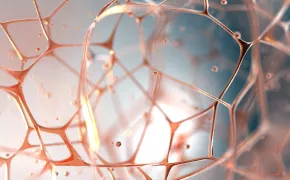Cord Blood & Cord Tissue
Your newborn's umbilical cord offers easy access to two different types of stem cells from two different sources, each with unique healing potential.
Untapped Potential
Cord Blood
The umbilical vein carries oxygen and nutrients to your baby during pregnancy. The blood flowing through this vein, cord blood, is rich in Hematopoietic Stem Cells (HSCs).
Cord Tissue
Cord tissue, aka Wharton's Jelly, is a gelatinous substance that surrounds and protects the vein and arteries in the cord, like a cushion. It's loaded with Mesenchymal Stem Cells (MSCs).
What makes stem cells special?
Stem cells possess remarkable natural qualities that offer healing potential and hope for treating a wide range of conditions. Stem cells can turn into various cell types, self-renew, regenerate, and replace damaged cells with healthy ones, making them capable of repair and restoration - like a biological repair kit.
Building blocks of life
Potential healing resource
Easily accessible at birth
How are cord blood and cord tissue stem cells different?
Cord Blood
Hematopoietic Stem Cells (HSCs) are "blood forming" stem cells responsible for creating all types of blood cells that build and maintain our blood and immune system including:
- Red Blood cells
- White Blood Cells
- Platelets
Cord Tissue
Mesenchymal Stem Cells (MSCs) have natural anti-inflammatory and regeneration properties and the potential to develop into various types of cells, including:
- Bone
- Cartilage
- Muscle
- Nerve Cells
How can cord blood and cord tissue be used?
Cord blood and cord tissue have the potential to help heal the body in different ways. Banking both increases the therapeutic possibilities for your family.
Cord Blood
Proven Use: Stem Cell Transplants
Cord blood has been a reliable, effective, and life-saving source of stem cells in transplant medicine for over 30 years. Nearly 80 conditions can use cord blood stem cells to regenerate a healthy blood and immune system for certain:
• Cancers
• Blood Disorders
• Immunodeficiencies
• Bone Marrow Failure Syndrome
• Metabolic Disorders
• Other Conditions
Clinical Trials: Regenerative Medicine
Cord blood has been used in regenerative medicine clinical trials to potentially regenerate or stimulate the body's own repair mechanisms for conditions like cerebral palsy.
Cord Tissue
Clinical Trials: Regenerative Medicine
Cord tissue has been used in regenerative medicine clinical trials to potentially regenerate or stimulate the body's own repair mechanisms for conditions that cord blood could not address like:
• Autoimmune Deficiencies
• Rheumatoid Arthritis
• Parkinson’s
• Alzheimer’s
• Neurological (Acquired)
Although there are no proven uses for cord tissue yet, researchers are excited about their potential to help address conditions that cord blood stem cells cannot.
Benefits beyond stem cells
Genetic Health Insights
Cord blood also contains a wealth of health information that can be used to help parents make proactive and informed decisions about their child's health and well-being. Only ViaCord offers additional DNA tests using a small sample of cord blood to access useful genetic health insights to support your child’s health journey, like:
- A child's predisposition to celiac disease and primary lactose intolerance
- Potential disease-causing variants in genes associated with actionable, childhood-onset conditions
- Medication Sensitivities

Newborn Stem Cell Banking
What is cord blood and tissue banking?
Cord blood and cord tissue banking, also called newborn stem cell banking or stem cell preservation, is the process of collecting, processing, cryogenically freezing, and storing stem cells from a newborn's umbilical cord for potential future use. It's a convenient option for families looking for ways to plan for their family's future health and an easy way to secure a potential healing resource.
How is cord blood & tissue collected?
Collection is safe, painless, can be done even with delayed cord clamping, and does not interfere with birth plans or baby bonding time. Everything your medical professional needs to perform the collection is included in our ViaCord Collection Kit. Here’s how it works:
After your baby is born, your healthcare provider will clamp and cut the umbilical cord, as usual.
A needle is inserted into the umbilical cord vein to drain the remaining blood into our collection bag
Once the blood is drained, the tissue remains. Your doctor will cut and store it in provided material
Why do families bank?
Parents choose to bank their newborn's cord blood and tissue stem cells for many reasons including:
Peace of Mind
Direct access to a potential healing resource if ever needed.
Today's Proven Uses
Cord blood can be used in nearly 80 conditions to regenerate a healthy blood and immune system.
Tomorrow's Possibilities
Cord blood and cord tissue use in clinical trials for potential new applications.
Lock In Youth
Newborn stem cells haven't been exposed to factors impacting stem cells later in life.
Family History
History of a condition that can currently use cord blood stem cells in treatment.
Related Source
Family members have chance of being a partial genetic match to cells.
Why do families choose ViaCord?
Here are just a few reasons why families choose to bank with ViaCord
Experience
Over 30 years of experience and the choice of hundreds of thousands of families.
Proven Quality
Over 600 families have used their cord blood in a stem cell transplant or clinical trial.
Accreditations
Only family bank accredited by the AABB for processing and storing newborn stem cells from both umbilical cord blood and cord tissue.
DNA Health Insights
Only ViaCord offers DNA tests using cord blood to unlock useful genetic health insights.
Cord Tissue Service
We process cord tissue stem cells prior to cryopreservation, unlike some banks.
Company Stability
We're part of, Revvity (NYSE: RVTY)., a publicly traded company and global leader in diagnostics.
Banking with ViaCord
Designed to be as easy and convenient as possible
-
Get Your Kit
Order your ViaCord Collection Kit online or over the phone and we’ll ship it to your house. It contains everything your medical team needs to perform the collection, including instructions.
-
Collect
Bring your kit to the hospital on delivery day and give it to your medical staff for them to perform the collection.
-
Call for pick up
We’ll pick up your completed collection kit at your location, arrange for transportation to our lab, and notify you when it's arrived!

Explore our banking services
We understand every family is unique. That's why we offer a range services that empower parents to plan for their family's future health in their own way.


















